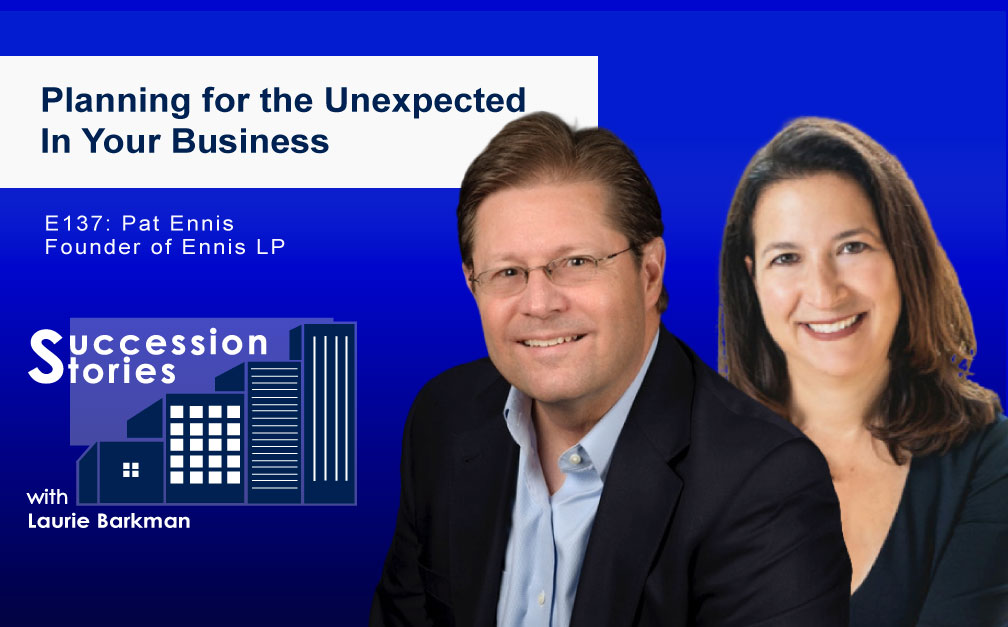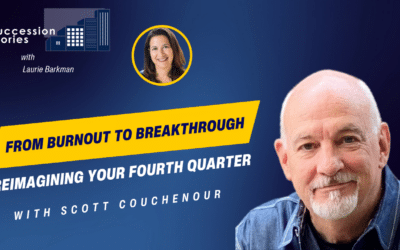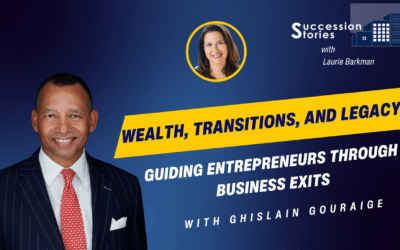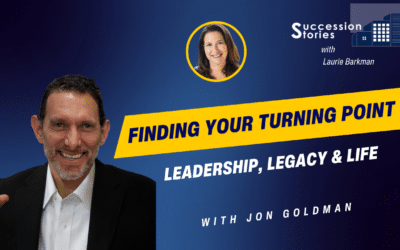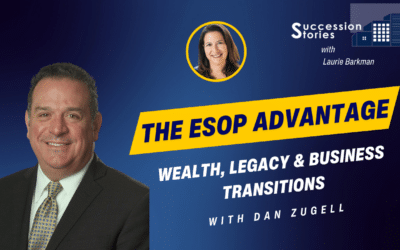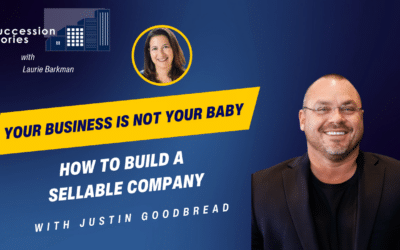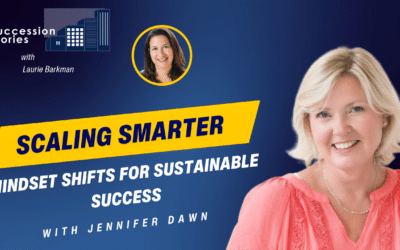Succession Stories host, Laurie Barkman, is joined by Pat Ennis, Founder of Ennis Legacy Partners. With decades of experience in financial services, Pat has extensive understanding of the challenges business owners face.
Because 100% of owners will eventually exit, it’s important to understand the 6Ds– risks that can derail a business like death, divorce, and disasters. Understandably these risks can feel like taboo topics so that’s why we’re diving in.
Pat Ennis
“Owners need a plan to prepare the business to maintain essential functions to avoid potential disaster or crisis.”
Learn why having an ownership contingency plan can enable you to preserve your business legacy, ensure business continuity, and prepare potential successors.
Listen in to learn more about:
- Importance of Planning
- 6 Ds and Business Continuity
- Avoiding Business Dissolution
- Key Planning Steps
Find Pat Here: https://ennislp.com/
My Links:
⏰️ Meet With Laurie: https://thebusinesstransitionsherpa.com/connect/
🎙 Podcast: https://podfollow.com/succession-stories
🌐 Website: https://TheBusinessTransitionSherpa.com
🎥 YouTube: https://www.youtube.com/@successionstoriespodcast
😎 Instagram: https://www.instagram.com/lauriebarkman/
✖️ Twitter: https://twitter.com/LaurieBarkman
😺 TikTok: https://www.tiktok.com/@businesstransitionsherpa
📘 THE BUSINESS TRANSITION HANDBOOK:
Get a free PDF copy of “The Business Transition Handbook” by author Laurie Barkman:
OR text TRANSITION to +1-762-320-2826
❤️ Show us the love: Submit a review on Apple Podcasts or Spotify
TRANSCRIPT:
Laurie Barkman
Pat Ennis, it is a delight to be with you today. I’m so glad we’re together on Succession Stories. You’ve been a gracious host to me two times on your podcast and I’m just so delighted to return the invitation.
Pat Ennis
Well, it’s very kind of you, Laurie. I was telling you earlier if I can be half the guest that you are, I’ll be excited and pleased.
Laurie Barkman
Well, thank you so much for that compliment. Why don’t you tell us first a little bit about you and how you got started in Exit Planning?
Pat Ennis
That’s a great question. Historically, My career was mostly in financial services, started on life insurance, when I was about 20 years old. Progressed into financial planning in the 80s, and ended up at Merrill Lynch and Fidelity Investments for a while in a boutique investment partner in a boutique or an investment firm, for a while too. For eight years, I was an executive director for a nonprofit and I got real interested in business owners at the time because they were some of our biggest, most generous givers, and just making a big impact on people. I got to know him and I got too interested in what their challenges were.
When it was time for me to move on and do something else, my wife continued to encourage me to become a consultant, doing management and leadership consulting because I’d had success in management in for-profit and in nonprofit. She said people come to you all the time for that. I said, Yeah, I know, they do but they don’t have any money. That’s why they come.
Finally, I listened to her and the listeners out there, husbands: listen sooner than later. Immediately, I had two pretty nice engagements. Because I’m a baby boomer, one of these clients, we’d be meeting with the client, and we’d be talking about building the business and growing it and building value and the owner was a man. So his wife would be in some of these meetings and she, she would say, “Hey, it’s great. You guys are talking about growing and building all the time but I don’t want to own this business eventually.”
This is a very real issue at the time because the gentleman had severe terminal health–chronic health conditions. They looked at me because I was a CFP and I started to put some pieces together in place. It turns out that it was a sort of Exit Planning. I didn’t know what Exit Planning was at the time. We had a board of advisors, my young firm, CPA, Walter Deyhle, he’s my co-host. He was saying, “Hey, I was describing the situation and he said, You know what that is, that’s extra planning. Because of all your other certifications and qualifications, you could probably get certified in it fairly quickly.”
I did and that was about nine years ago. Because we’re baby boomers, that’s become pretty much the tip of our spear. We are legit.
Laurie Barkman
X in the space.
Pat Ennis
We’ve gotten over a few hops. We’ve made a lot of mistakes probably early on but now we think we know what we’re doing. That’s how it happened. That’s the believe-it-or-not, the nutshell version
Laurie Barkman
That makes sense. You’ve came into it from the financial planning side, which in people know for listeners of this show, I’ve had folks like yourself on who are specific to Exit Planning, but of course, it intersects with all these other components.
The component that I want to talk about today with you and you hinted at is business continuity planning, in that example, you talked about the husband and wife, and had some health issues. Business continuity planning sounds like a phrase, people might not know what that really means. Let’s start there. What is it and why is it important?
Pat Ennis
The problem is this: the business continues if the owner is not able to run the business, be it because of unexpected death, permanent incapacity, whatever it might be. We believe that an owner needs a plan for that to prepare the business to maintain essential functions if indeed a potential to avoid potential disaster or a crisis. Basically, continuity issues fall into two categories: those that occur while an owner is alive living like a pandemic, natural disaster, cyber attack, whatever it is an external threat. The other category, and this is what we’re going to talk about here today, is you and may that arise when an owner unexpectedly passes away or becomes disabled. It’s a plan for those situations.
Laurie Barkman
We sometimes refer to these as the Ds, there’s five of them, or there are six of them. You’ve mentioned quite a few. I like how you split them at the top, which is while the owner is alive, and while the owner is gone. 100% of us are gonna leave our company one day and we can sort of, say tongue in cheek here, they’re either going to leave horizontally or vertically.
We’re in the situation, at least kind of in this conversation today to help businesses plan for the unexpected. Unfortunately, we know what’s going to happen. That’s the big why, right? That’s the big why. Why don’t you share a story or two, just to give an illustration? Let’s start with a story where things did not go well. I know you’re probably trying to help the client, but it’s not your fault.
Pat Ennis
Well, sadly, I mean, there’s not, there’s not a few of those stories, you know, I’m 64 years old. And I’ve been doing this kind of work for a while now. And so it’s not unusual to, to either indirectly or directly be involved. One comes to mind pretty much because it was severe. And and so it was a Monday morning, and I got a call from or an email and a call, I think from a banker who a regional bank, they they refer us their clients to help them with this and Exit Planning and stuff like that. And she said, Hey, over the weekend, one of our banking clients, who owns a business passed away unexpectedly. He was 62 years old. And he until now, no one knew he had any health issues very healthy. And so I know you can’t really do anything to help now, but I know it’ll help his wife, the spouse, if you at least talk to her. And I said, Of course, yeah, of course, I’ll do that. And so I talked to her, and indeed, the NS was, the gentleman had been in business for 20 years or so. Local here in montgomery county. He was central to the business. And I’ll tell you why I know these things about him. In just a second, he was central to the business. Again, healthy, unexpected. It we’ll call him John Doe, Jane, his wife, I’m talking to Jane, she had no experience or knowledge of the business she had. She wasn’t working in it. She didn’t have she would. And so you know, her husband just passed away on the weekend. That’s one thing that’s tragic in itself. But now she’s absolutely clueless as to what to do with this business. She had no instructions. And come to find out there was not an estate plan in place. And by the way, and you know, this you you say this, I’m sure that you can’t do Exit Planning without doing estate planning. While there wasn’t an estate plan in place, there wasn’t clear instructions as to who to call what to do short term long term. No one knew what John Doe’s wishes were regarding the future of the business. There was no plan to retain any, any key people any key employees. So, clearly the environment or atmosphere was very tense and lacking instability and, and it which always results in a lack of employees, losing employees and then eventually customers, right. And so this could have all been prevented with some planning, which we’re going to talk about here this morning. Now, here’s what makes this even more and this is the situation comes to mind pretty quick. Because of this, I had met with this man, five years earlier, and a donut shop. And I didn’t think it was going to be a real. I didn’t think he was going to be a client. But I gave him some advice. I gave him like, five, do these five things. If you and I never talked again, please just go do these things. Well, he didn’t do any. And, and so we ended up with this very tragic situation. The financial future of the the wife, kids were grown. That was good. But financial future the wife is was in question, of course. So anyway, that’s, that’s an example I could go on. But I’ll just stop there and let you respond to
Laurie Barkman
those. Those situations are much more common than we think as you as you alluded to. We’ve had folks come on the show, we had Jennifer Marriott had been involved in two turnarounds both related to the death of an owner. In the first company, it was her aunt. And when the aunt passed away, she was young, she was in her young 50s. And she was the glue in the back office. And when the aunt passed away, like you were talking about processes, nothing was documented. Jennifer had to step in and try to figure out how do we pay people, she had posted notes all over her desk, and Jennifer had to try to figure it all out. Eventually they did, but it was it was almost a crisis. And the second
Pat Ennis
Yeah, so she had no, she just had to go in and figure
Laurie Barkman
it all out. He just had to go in she was in the marketing department. And her dad was the owner, with his sister, the aunt. And the aunt passed away unexpectedly. In the other situation, Jennifer was brought in as an outside CEO to help with a turnaround because there was the death of the owner. And the business already was not doing well. And she helped her turn that around completely. Both situations, the company were the companies were headed into a tailspin. There were no like, you know, things that you alluded to right? There were no instructions. People didn’t know what was going on. And it could have been very expected for employees sleeve, why should they stay? This is a sinking ship? What should What should I do here? It’s, it’s it’s boggling my mind sometimes to have conversation with a client. And they say, Well, my son or daughter will figure it out. Ya know, they’re in mourning, first of all. And second of all, they’re not really part of the business. And they don’t really know the inner workings. They don’t know your wishes. How do you think that that’s going to end? You know, how do we think your key employees are going to how to react to that they’re going to stay on?
Pat Ennis
Stats, the statistics aren’t in your favor. I mean, particularly because the kids, you know, this, the kids don’t always end up being great owners to begin with, even even in great circumstances, you know, even if the business doing real well. And there was a clear plan for a situation like this doesn’t guarantee that the kid who may have been a very good employee is going to end up being a great owner. But then you put them in to the end, and what and one of the the key attributes of entrepreneur owner is they can go to bed at night with all the risk. And, you know, all the stress that that’s entailed there. Well, you put this situation and layer this in on top of just the the normal risk of owning a business. Oh, my gosh, it’s right. It’s
Laurie Barkman
it’s a lot. What would be the five things that you said to that gentleman? What What were those five things? Yeah.
Pat Ennis
Well, let’s, let’s, let’s see if I can. Well, I told him, first off, he was extremely central to the business. Right. So and he had no successor, and he was a sole owner. And sole owners have different issues, don’t they? You know, this? Let’s talk about different business continuity issues, then then do partners both have things they have to plan for, but the sole owner, one of the big issues that they have to plan for is the continuity of ownership. And who’s going to own this next after me? Well, he hadn’t done anything about that. So yeah, he didn’t have an estate plan in place. I knew that I asked him, and he said, If you don’t do it, I there may here’s probably five things, this was at the top of the list. Well, there are two things at the top was, go get an estate planning attorney, if you need one, I’ll get one for you. But get that going, because it’ll force a lot of these other questions and issues. He didn’t do that. And so that was one thing, another thing I told him to do was to create, and I gave him a template for this. And I’ll give anyone who’s listing a template for this, too. If they want one for business continuity instructions, you could do the same, I’m sure where, you know, you document what needs to be done short term, what needs to be done long term. I did that. And I told him to get with his financial advisor, and make sure everything’s in order there. And I told him to start thinking about is there anyone that he can train as a successor to make him less central to the business, but then also, who may be potentially could mine his business, eventually giving him another option? So there’s probably four things I it, you know, it may not have been five, it may have been three, three to five, but those I know, I would have said those things done.
Laurie Barkman
Yeah, one of the things we want to avoid is going to probate. Can you share why that why we want to avoid going to probate? Well, probate
Pat Ennis
can take time, and it just adds to the stress of the situation like this, this lady she was gonna have to go through probate.
Laurie Barkman
Like he has a court proceeding. Yeah,
Pat Ennis
yeah, absolutely. So that brings up a good issue the more often than not? Well, whenever we’re dealing with its sole owner, we will tell them and usually we meet with them and their estate plan or together, we’ll ask the estate planning attorney. And in John Doe, or Jane DOE’s situation, what it makes sense as a sole owner, for them with how their business is structured, to put it into a revocable living trust, so that you can avoid, you can avoid probate, and it makes the continuity process that much smoother. If something indeed does happen. Yeah, and if that was a good, good issue, you brought it there.
Laurie Barkman
Yeah, tied to that. I’m gonna just let’s stay on the sole proprietor topic for a second. If a person is a sole proprietor, and they pass away, and there’s no change of ownership plan in place, this business will dissolve correct with the owner’s death?
Pat Ennis
Well, it depends on the structure. If it’s an LLC, then then if, if no one else owns it, with them, if it’s their business, then yeah, it’s good chance it’s gonna dissolve. The the. Yeah, and so, and here’s the thing, if it does, like, in this case with Jane Doe, she was still depending on income from their business, and there was no way for it to continue. Because she didn’t know anything about it, and key employees are starting to jump ship. Right. So the loss of the planning issues really, are these the these are the these are the questions that what would you or would you the business owner, John Jane, would you want or need the business to continue at your death or permanent incapacity? How and to whom? Would the ownership of the business be transferred? Can the business survive without your financial support? Because a lot of times, you see, I’m saying all this stuff to you, you know, all this stuff. But listeners, can a business survive, survive without your financial support, particularly if you’re a solo owner? Can a business survive without your talents? It couldn’t without this gentleman’s talents, his knowledge, his experience, he still had the key relationships, all of that. And then can the business survive if key employees and then usually customers leave after key employees do because the service level goes down, work doesn’t get fulfilled, and so on and so forth. So those are the key issues or the key questions that really expose the key planning issues. us. How about you want to hear good stories?
Laurie Barkman
I did. I was gonna say we talked about a scenario that didn’t go so well, share with us a scenario where it did.
Pat Ennis
Well, it’s current client and two partners. This is different in that it’s a partnership and not a sole owner. They’ve been in business together for 20 years or so. A phenomenal partnership, they share the same core values, and they may have robust debate and everything about stuff. But at the end of the day, they come together and get it done. They have a current review in the last year Buy-Sell agreement has been reviewed.
I reviewed it, the attorney did a phenomenal job, but it’s funded with insured and I’ll tell you why that’s important. here in a second, it’s funded with both life insurance and disability buyout insurance. They’re both in the process of updating their estate plans and their plan for wealth management. They’ve also had their insurance people and we meet, like, you will meet with all these different advisors and so they’ve had all their insurance coverage reviewed both on the personal side and business side to include ownership and beneficiaries. Just making sure all of that’s online. The successors are in place for both, let’s call them Jim and Joe successors are in place for both of those guys and two levels below them.
There’s clarity as to what happens if one of the two of them is no longer available. The key people on staff know the plan, it’s been communicated. There’s going to be plenty of liquidity for sure, any short-term cash needs. If something happens to either one of these guys, including the replacement of their skills and knowledge of the last owner. There are incentive plans being put in place to align with growing the business but also retaining key people in the event. So one of these two guys, something happens to him. And all of this, all of that planning lands toward the complete opposite, doesn’t it of the other situation, it leans toward peace, stability, the goals of the owners being accomplished, it’s complete.
It’s the complete opposite 380-degree situation and here’s what’s really one of the gentlemen just learned within the last few months. He’s got cancer and we are hoping and praying that he beats it. He had cancer 10 years ago, and he beat it this time. He’s 10 years older. He’s my age, and, and we’re praying and hoping that he beats yet again. But they all know that, if God makes something did happen to him, there is the box that i’s are dotted, the T’s are crossed, and it’s a good feeling. They already have peace and stability situation.
Laurie Barkman
Yeah, absolutely. Well, yeah, we’re all hoping that that turns into a happy outcome. But if not that they’ve been they’ve been preparing. And that’s a good thing. And I think owners, it’s almost like a taboo topic. To talk about these things. It’s very uncomfortable, I don’t want to think about my death. It’s morbid, right? But if we think about it, as it’s our legacy, and the name of your firm legacy partners, isn’t that the intent?
Pat Ennis
Well, it is everything, all the work that you do all the work that we do is the foundation. It is what the goals, the dreams, the desires of the owner are and so just like you we work real hard to find out that information, and sometimes it is legacy and values-based goals like these two guys here, real strong values based goals as strong as any financial goals they have. Whereas maybe there are other owners that none it’s so much for. We want to cash out and move on as quickly as possible or we want to life-changing liquidation events and there are values in there, of course, but it’s the financial piece that they can be most, some are most fun. And that’s fine. We just need to figure out right? Don’t wait for what they want, and then help them help them realize whatever it is they want.
Laurie Barkman
Yeah, and you do a fantastic job of that. Let’s start to wind down a little bit here. We’ve talked about a lot of concepts on the table. If you were going to summarize into three things that you want our listeners to take away and say, I’m going to do these three things and I’m going to do them in the next 90 days, what would they be good.
Pat Ennis
We liked to work in 90-day sprints. That’s really good. Laurie, so again, the planning issues are these continuities of ownership, loss of financial resources that you’re bringing to the table currently, loss of your skills and talents and knowledge, and loss of key employees. So absolutely, if you’ve not reviewed your estate plan, in the last three years, please do that with your state planning attorney, if you do not have documented, and what we would call business continuity instructions, short-term and long-term actions and instructions for whoever’s left behind. Please do that.
Jjust by going through that process and filling out a document like that, it’s going to raise a whole lot of other questions and issues. That’s why I like to suggest those two things, if nothing else, because those two things edge. Again, I’m preaching to the wire here with you just exposing a lot of other planning questions and issues. Now, the estate planning attorney, if you have a good one, they’ll do a really good job of getting everything in place to transfer ownership the right way. It’s not their job to think about how you’re going to retain key employees, which is absolutely essential if you want that business to continue. So state plan business continuity instructions and think about who your successor is, and how that successor can be retained. If something were to happen to you, those three things I could go on but those are three things.
Laurie Barkman
Just to underscore something you said earlier, which is the funding mechanism for the ownership successors through a Buy-Sell agreement to be funded through insurance. That is really important. It kind of goes along with your number three, I just want to tag it on there. Because it’s it’s an insurance provider, that’s going to help you think through how all of the money is going to flow from one party to another.
Pat Ennis
Thanks for bringing that up. For two reasons for you, insurance is one of those things that you’re not–it’s one of the only things you’re not guaranteed you can get for the rest of your life. Sometimes you can get it. Like if my friend went to try, my client and friend went to try to buy life insurance now. Either wouldn’t get it or he’d have to pay about as much as the face amount to get it. But he had, he already had. So he was good. So that’s a reason to always stay current with that. Oh, one other thing, if there’s a partnership, make sure to review your buy-sell agreement regularly. So that’s kind of a fourth thing for further if you’ve got one or more partners.
Laurie Barkman
And just to back it up a step. If you don’t have an estate plan or if you don’t have a Buy-Sell agreement, and you want to learn more about those things. We would definitely advocate for that. I’m sure you’ve covered on your show, and we have to but you can google those terms and definitely learn more about them. Pat, you’re a wealth of knowledge. If people want to follow up with you and contact you what’s a good way to get in touch?
Pat Ennis
Well, thanks for asking. The phone number is 330185908 and the email is email@ennislp.com and ennislp.com is our primary website exitreadiness.com. We built that for smaller Mainstreet business owners who want to try to do it themselves. We got to Do It Yourself resources on there but those are the ways.
Laurie, thanks for having me. I mean, you’re a phenomenal guest I’ve had you on twice. You’re phenomenal but you’re a great interviewer too. I really appreciate that. Congratulations on your book and congratulations on your award-winning podcast. I understand why and just the impact you’re having with the work that you’re doing.
Laurie Barkman
Thank you so much. That really means a lot to me. I appreciate your coming on. I appreciate our working relationship and education. That’s what we’re trying to do, we’re trying to help our audience we’re trying to help business owners avoid exit regrets and create value. And I believe this episode is a key part of that. Pat, thank you so much for coming on Succession Stories today.
Pat Ennis
You’re more than welcome. Glad to be here.
Laurie Barkman
To our listeners, be sure to follow Succession Stories in your favorite podcast player and on YouTube and be sure to leave us a review. We really appreciate that. To learn more about maximizing the value of your business and planning for transition, book a complimentary call with me at thebusinesstransitionsherpa.com. Join us next time on Succession Stories for more insights from transition to transaction.

